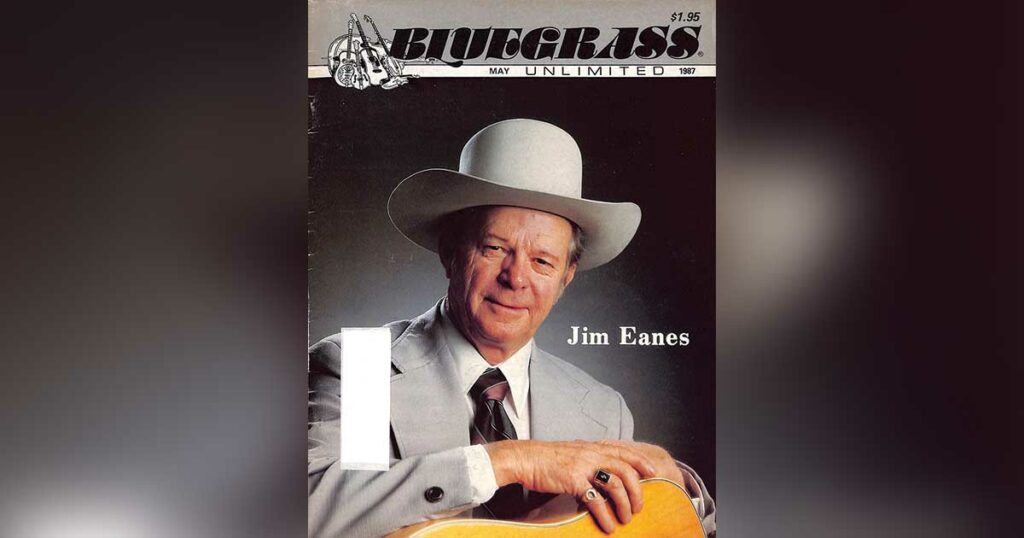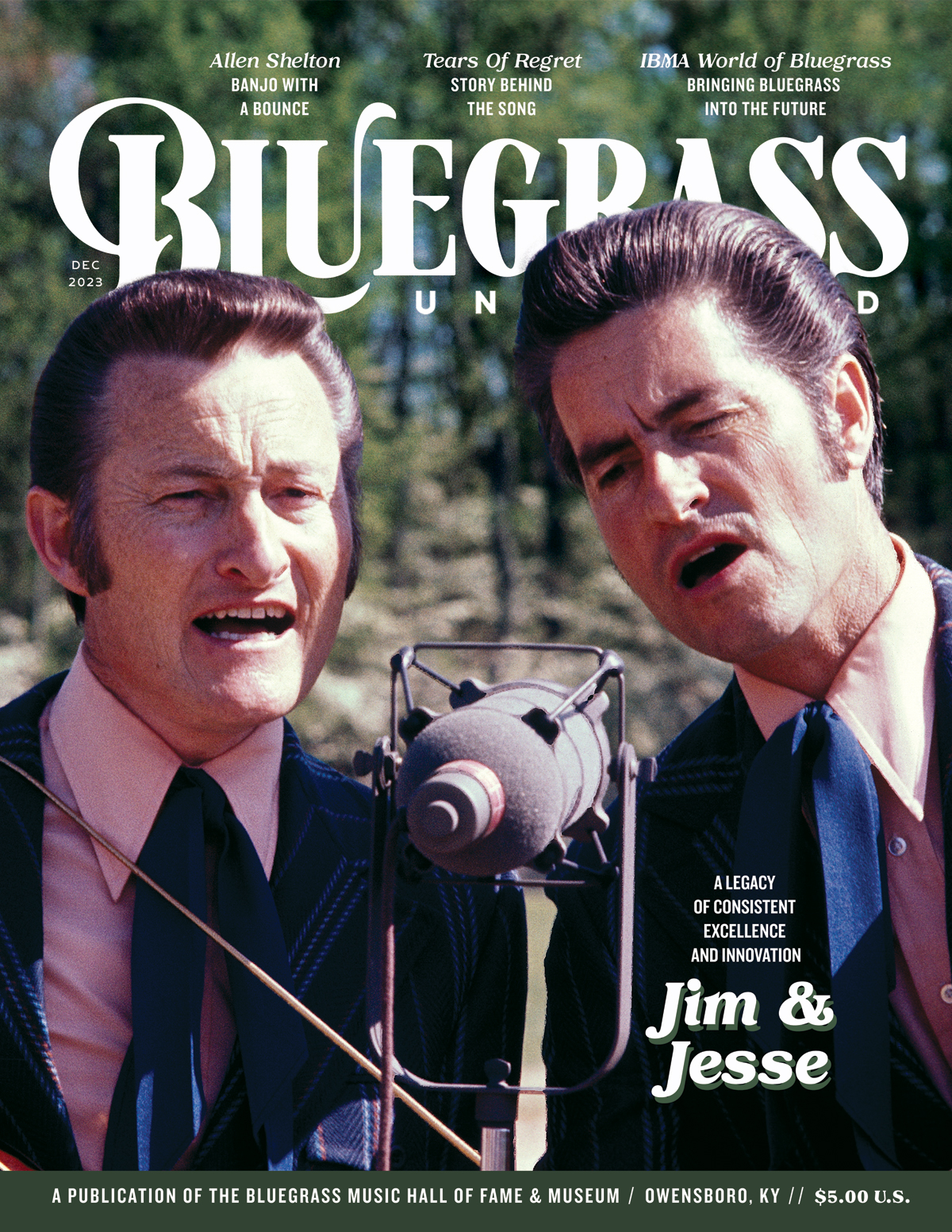Home > Articles > The Archives > Jim Eanes
Jim Eanes
Reprinted from Bluegrass Unlimited Magazine
May 1987, Volume 21, Number 11
Among the musicians who pioneered in the development of bluegrass music, one of the most gifted and enduring was “Smilin’ ” Jim Eanes from Martinsville, Virginia. His contributions to the music are many, both in terms of fronting a very popular and successful band (the Shenandoah Valley Boys) and as an excellent songwriter. Songs which he wrote or co-wrote are considered standards in bluegrass and country music and include titles such as “Baby Blue Eyes,” “Next Sunday Darling Is My Birthday,” “I Wouldn’t Change You If I Could,” “You’d Better Wake Up,” and “Your Old Standby.” He is also respected as an excellent master of ceremonies and radio personality, having worked on a number of stations throughout southwestern Virginia since the mid 1950s.
Jim’s interest in music began early in life, acquiring an appreciation of what he calls “old-time hillbilly music” from his father who played 5-string banjo. His determination to play stemmed from an affliction with his left hand, caused by a burn, which many people felt would never allow him to play. Several early situations which were embarrassing to Jim only increased his desire to perform and after a year’s time he was able to play the guitar. His first time to perform in public came when the guitar player for his father’s band failed to appear at a dance and Jim was able to fill in. The next five years were spent in his father’s band, playing dances and shows throughout the Martinsville area.
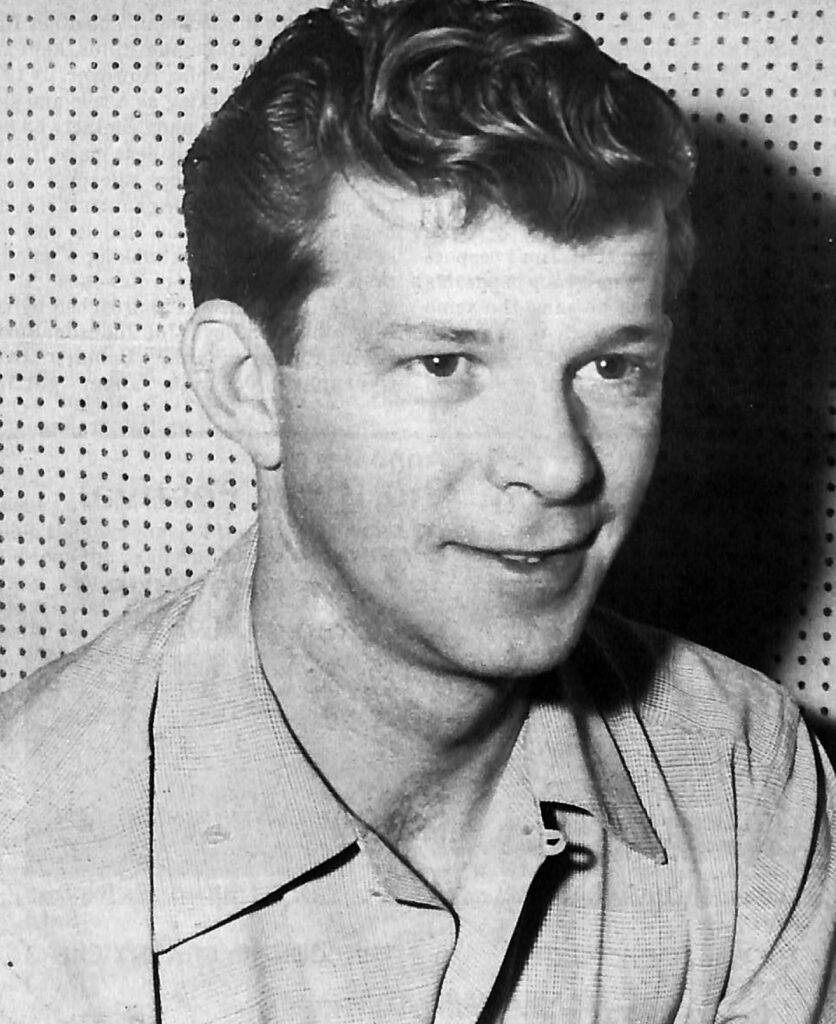
In 1939, Johnny Schultz, a promoter and radio station manager from Martinsville, asked Jim to appear on some shows which he promoted from the local wrestling arena. Initially, Jim worked as a solo or with other groups but later was able to include his father’s band, Uncle Bob Eanes and the Mountain Valley Bootleggers. It was at this time that Jim acquired his stage name. Johnny Schultz didn’t think that Homer (Jim’s given name) would be a good name for an entertainer and came up with the name “Smilin’ ” Jim Eanes, which Jim has used ever since. In addition to the work at the wrestling arena, Johnny Schultz also organized a series of shows at different theatres throughout the area. Featured on the programs were many local groups (Woody Mash and the Sons Of The Soil, Wallace Tuttle, Red and Thurman Nance, Bob Biggs, Leland Light, etc.) which were comprised of excellent musicians and the overall feel of the shows was similar to a small version of the Grand Ole Opry. The programs ran for several years, into the 1940s, and were eventually broadcast over local radio stations. During this time, Jim worked mostly as a solo, earning about $1.50 every Saturday night.
It was also in 1939 that Jim worked with Roy Hall and the Blue Ridge Entertainers, (see BU, Sept. 1978). He had met Roy at a personal appearance in Bassett, Virginia and Roy was impressed with Jim’s singing. At the time, Jim was working in the American Furniture factory but he readily accepted Roy’s offer of $25.00 a week. Roy at that time was a very popular touring and recording artist, recording for RCA Victor, and also appeared daily over radio station WDBJ in Roanoke, Virginia. The switch to Roy’s band proved to be a valuable move as well as a very enjoyable one. In the band, Jim was featured as a soloist but he also sang many of the old brother-style duets with Roy’s brother, Jay Hugh Hall. The band also included the legendary Tommy Magness on fiddle, Gordon Reed on bass, and Hank Anglin on banjo.
Radio played an important part in Jim’s musical development. During the 1930s. he listened regulary to WPTF in Raleigh, North Carolina and heard such entertainers as the Smiling Rangers (Steve Ledford, Clyde Moody, Jay Hugh Hall), Wade Mainer and the Sons Of The Mountaineers, the Lone Star Quartet, the Tobacco Tags, and the Briarhoppers. Many of the songs which he heard on radio then were songs which he later did with Roy Hall, especially the duet numbers which were featured by Clyde Moody and Jay Hugh Hall. Jim’s respect and admiration for this group made his job a lot easier when he sang the same duets with Jay Hugh Hall in the Blue Ridge Entertainers.
Jim’s stay with Roy Hall came to an end in May of 1943 when Roy was killed in an automobile accident. The other Hall Brothers, Jay Hugh and Rufus, kept the band going for a while. However, by 1945 Jim was back working as a solo and selling insurance. The many contacts he had made in the music business made it easy for him as an insurance salesman. Also, the hours were flexible enough that it did not interfere with his music and for several years he was making a comfortable living with two professions.
In 1946, Jim was approached by the Blue Mountain Boys (Joe Johnson, Burke Barbour, and Happy Bobbitt) from Lynchburg, Virginia about getting together. He agreed to give it a try and soon the group was working on the radio in Martinsville and playing some local dates. In early 1947 they moved to WBOB in Galax and later in 1947 they moved to the Tennessee Barndance which was featured over WNOX in Knoxville, Tennessee. Among the performers on the Barndance were Charlie Monroe and Kentucky Partners, Archie Campbell, Sunshine Slim Sweet, the Carlisle Brothers, Carl Story and the Rambling Mountaineers, etc. While working with the Blue Mountain Boys in Knoxville, Jim began writing songs, the first being his ever popular “Baby Blue Eyes.” Also while in Knoxville the Blue Mountain Boys recorded approximately thirty-two songs for National Records, a label which was located in New York. Unfortunately, only two sides from these sessions were ever issued. The Blue Mountain Boys stayed in Knoxville for about nine months but were unable to make any money. Towards the end of their stay, Jim left the Blue Mountain Boys and returned to Martinsville to operate a record shop and do solo work on the local radio station.
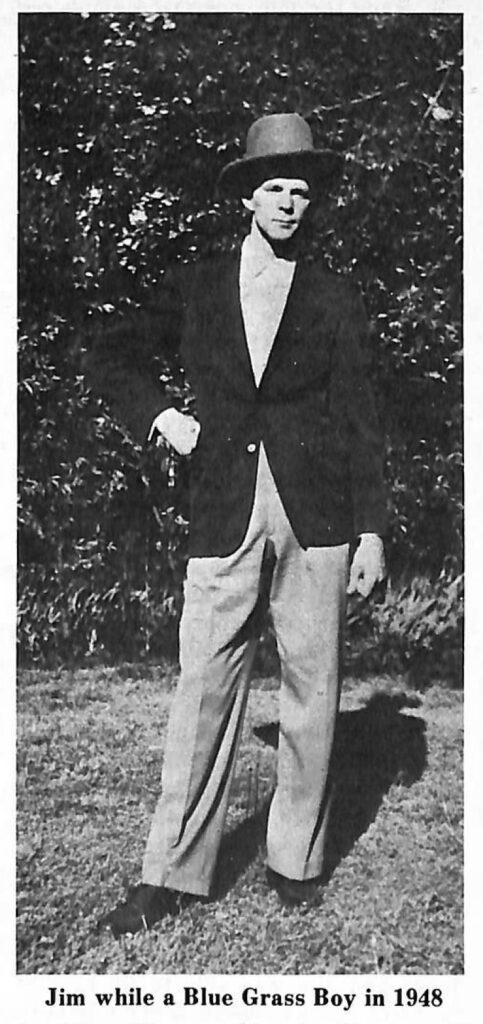
In January of 1948, Bill Monroe and the Blue Grass Boys played a show in Danville, Virginia. This turned out to be one of the last performances of Monroe’s classic band with Lester Flatt and Earl Scruggs. Jim was approached by Lester about the possibility of doing some work together and about two weeks after the show, he received word to get in touch with the Foggy Mountain Boys. Their first work together was at radio station WDVA in Danville. Jim, along with Cedric Rainwater (Howard Watts), did quite a bit of work getting bookings for the band. However, after being together only about three or four weeks, Jim received a telegram from Bill Monroe asking if he would come to work with the Blue Grass Boys. He readily agreed and was soon at work in Nashville.
Of the time spent with Monroe, Jim recalled that it was a very good experience. He was impressed with Bill’s knowledge of the music and was particularly struck by the fact that Bill played strictly by the melody. Although he admired Bill’s music, Jim admitted that he couldn’t sing with Bill very well. Jim was used to singing in C and F and lower chords, singing country songs, while Monroe was used to singing in B and B flat. In fact, on his first Opry appearance with Monroe, Jim had to stand on his tiptoes and strain to hit the notes. The group at the time included Joel Price on bass, Benny Martin on fiddle, Don Reno on banjo, and Jackie Phelps who, curiously, played electric and steel guitar with the group. The group spent quite a bit of time on the road but always returned to Nashville on Saturday nights to play the Opry. In addition, they also had a Saturday afternoon program on WSM which ran at 5:00 p.m. Their spot on the Opry, which was sponsored by Walrite Paint, was always at 10:00 p.m.
Following his tour with Monroe, Jim returned to Martinsville and started in the record business again. On one of his trips to get records from a distributor which was located in Charlotte, North Carolina, one of Jim’s partners signed him up for a talent contest which was sponsored by Capitol Records. Jim performed two selections for the contest and promptly left to return to Martinsville. He was notified later that evening that he was one of two winners in the country category and had won a recording contract with Capitol Records. The next day, Jim returned to Charlotte to record two sides: “Baby Blue Eyes” and “You Better Wake Up.” Included on the session was Tommy Faile, also a contest winner, Snuffy Jenkins, Homer Sherrill, and Fred Rose.
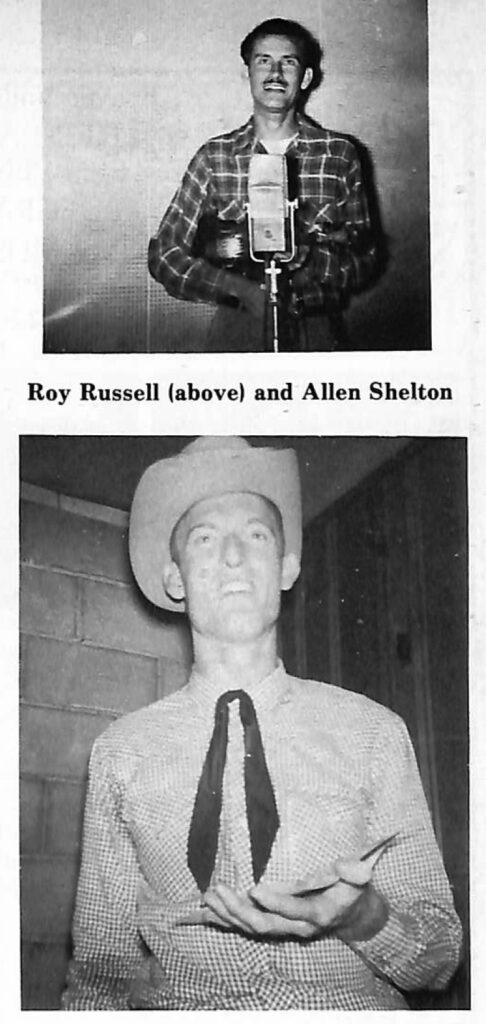
Jim continued to work the record business in Martinsville in the late 1940s and also did some radio work. For several months, he moved to California and while there recorded another session for Capitol. However, work was slim and he returned to Martinsville, intending to go to the Tennessee Barndance in Knoxville. His plans changed when he received a call from Clyde Moody informing him that he [Clyde] was leaving Danville and offered his radio spot to Jim. He accepted and started doing daily radio work on WDVA. In addition to the daily radio, there was also a Saturday night jamboree on which he worked as a solo. Response to the jamboree was so good that after a few months Jim decided to organize a band, the first edition of the Shenandoah Valley Boys. This included Hubert Davis from Shelby, North Carolina on banjo, Pee Wee Davis, Hubert’s brother, on fiddle, and Neely Gilfillian on guitar and tenor vocals. Continued good response to the jamboree led to increased work for the Shenandoah Valley Boys and soon they were working almost every night of the week. They stayed on the jamboree for about two and a half years. During this time, the personnel of the group changed and soon the band was comprised of what many consider the classic group of Shenandoah Valley Boys, that which included Roy Russell on fiddle, and Allen Shelton banjo.
In the early 1950s, Jim was approached by Drusilla Adams of Blue Ridge Records about the possibility of recording. As Jim’s contract for Capitol had expired, he readily agreed to record and from his first Blue Ridge session came one of his biggest hits, a song which he and Arthur Q. Smith had co-written called “Missing In Action.” The record is reported to have sold in excess of 400,000 units. Several years ago, as part of their Early Days Of Bluegrass series, Rounder Records reissued the fine Blue Ridge material which Jim recorded.
The success which Jim achieved on Blue Ridge led to a major label recording contract. He had offers from three labels to record and upon the advice of Troy Martin of the Peer-Southern organization he signed up with Decca Records. Among the more popular songs he recorded for Decca are “I Cried Again,” a song which was covered several times in the 1950s by other country and bluegrass artists, “Little Brown Hand,” “Wiggle Worm Wiggle,” “Rose Garden Waltz,” and “Just Suppose.” The material was mostly country in nature although several of the tunes were solid bluegrass, including several instrumentals with Hubert Davis on banjo: “Riding The Waves” and “Plunkin’ Rag.”
In 1955, Jim dissolved the Shenandoah Valley Boys and went to work for his old friend, Johhny Schultz, as a disc jockey in South Hill, Virginia. This was Jim’s first work as a DJ and he received a quick crash course from Johnny, who gave him a half hour tour of the station and promptly left Jim on his own at the console while he went into town for breakfast! Jim stayed on in South Hill for about eight months at which time Johnny Schultz built a new station (WHEE) in Martinsville and Jim, along with Louis Compton, opened the station. Jim’s tenure at WHEE lasted for eleven years.
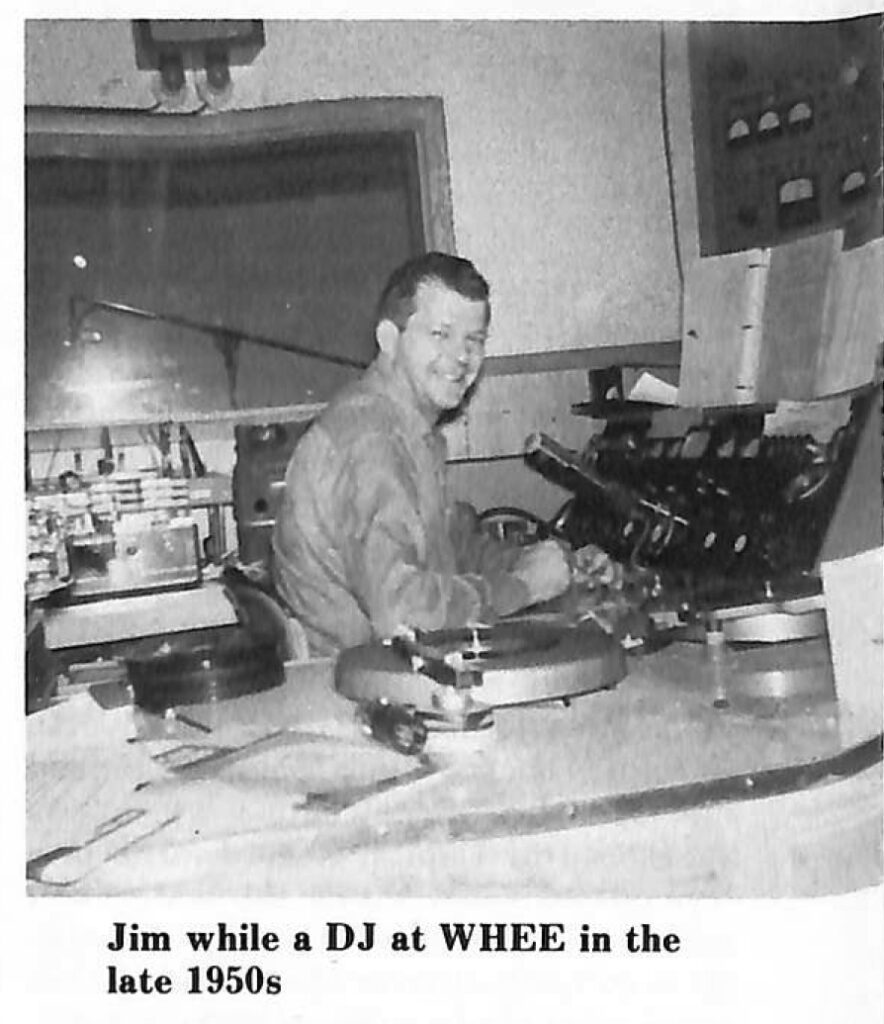
In connection with Jim’s work at WHEE, he represented the station at the DJ convention in Nashville. At one of the first conventions, he was approached by Starday Records about recording. His first session for Starday was held in the latter part of 1955. For the session he contacted members of the Shenandoah Valley Boys (Allen Shelton, etc.) and recorded two songs at radio station WPTF in Raleigh, North Carolina. The first two songs recorded were “Your Old Standby” and “Don’t Stop Now.” “Standby” has gone on to become one of “the” Jim Eanes classics and is one of the songs most associated with him. Jim stayed with Starday until 1962, recording many fine songs which still remain popular today; songs such as “Little Old Log Cabin In The Lane,” “Your Old Standby,” “I Wouldn’t Change You If I Could,” etc. The success of the Starday records prompted Jim to reorganize the Shenandoah Valley Boys and for several years he did a combination of working as a DJ at WHEE and playing show dates. Their popularity from daily radio shows and weekend barn dances kept the group busy every weekend.
Jim continued to record for Starday until the early 1960s. The last tunes he recorded for Starday were “Mary Was A Little Lamb” and “You Made Me What I Am.” These sides featured the banjo work of a young Gene Parker, currently playing with the popular Lost & Found. Gene had been a big fan of Allen Shelton’s and when Allen left to go with Jim & Jesse in 1959, Gene was a natural replacement. Following the final session for Starday, Jim recorded for Salem Records of Salem, Virginia. One of the more popular tunes recorded for Salem was a song written by Rod Shively called “Riding The Roads.”
In 1964, Jim started the first of his three publishing concerns. The first was Hoedown Music which was eventually sold to Glen Parks of Richmond, Virginia. Next he formed Old Standby Music with Margaret Patterson, a Roanoke native who did much to help promote Jim during the 1950s and ’60s. Later, in 1970, he started his current publishing firm, Home Of Eanes Music.
The Shenandoah Valley Boys remained together until 1964, playing regularly at the Virginia-Carolina Barn Dance. In 1964, Jim’s longtime employer and friend, Johnny Schultz, died, leaving him without a job. For the next several years, Jim drifted around to different radio stations, doing DJ work and also working as a solo. In 1967, he went to WWVA in Wheeling, West Virginia and worked on the Jamboree. He had a solo spot for 15 minutes and then had an additional 15 minute spot during which he was backed up by Red Smiley and the Bluegrass Cut-Ups. Jim’s work with Red set the stage for his working with the Bluegrass Cut-Ups. Following Red’s retirement from the music business, Jim received a call from John Palmer (bass player in the group) to get together with the band. Jim readily agreed and they changed the name of the group to the Shenandoah Cut-Ups, incorporating parts of both groups’ names. The Cut-Ups continued to work the WWVA Jamboree for about another year but due to the slim monetary rewards, the group eventually curtailed their performances there.
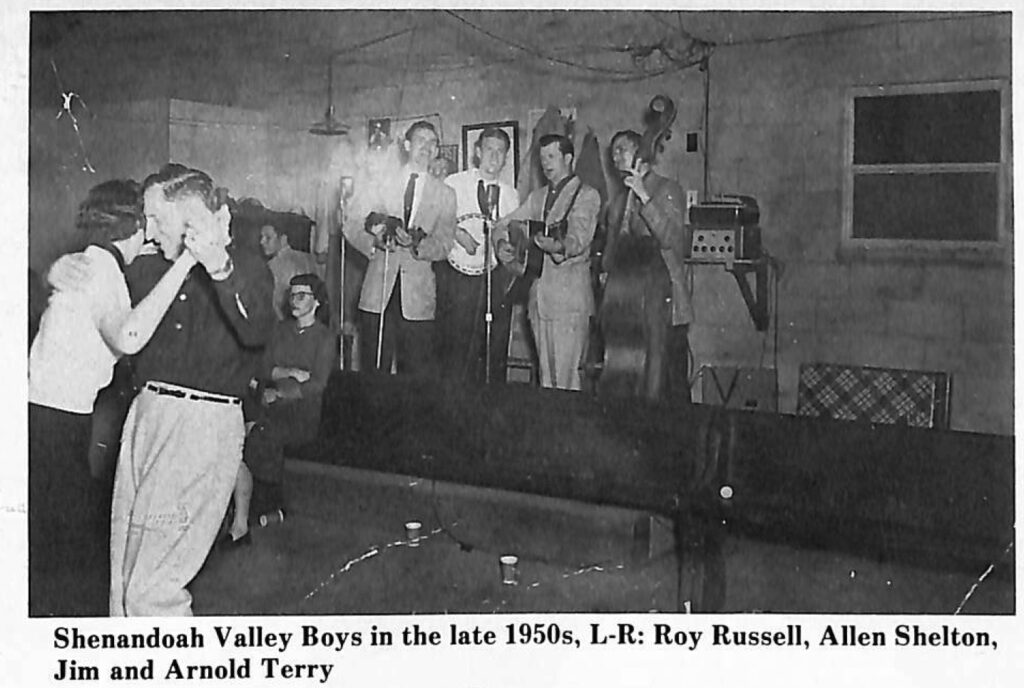
During the late 1960s, Jim recorded on several occasions. One album, titled “Your Old Standby,” was recorded for Zap Records, then a budget line for Rebel Records. For this album, Jim was backed by members of the Country Gentlemen (John Duffey, Charlie Waller, Ed Ferris) and Walter Hensley (banjo) and Russ Hooper (Dobro). Two additional albums were recorded for Uncle Jim O’Neal’s Rural Rhythm label. The first of these two albums was recorded with Red Smiley and the second was recorded with the Cut-Ups. The album with the Cut- Ups was more of a country-oriented album. A sacred album was also recorded for County Records. This was an excellent collection which featured several fine Jim Eanes’ originals, including “In His Arms I’m Not Afraid” and “Let Him Lead You.”
Jim’s association with the Cut-Ups lasted until 1970 at which time he went back to work at various radio stations. This lasted until 1972. For the next few years he worked at festivals and shows as an MC and also did some solo work. In 1978, he suffered a heart attack and for the next year or so was completely out of the music business. Though his health was still not what it should have been, he accepted an invitation in 1979 to tour Europe. This was the first of three tours to Europe with two more following in 1980 and 1982. On the second tour he recorded an album with the popular European band, Smoketown Strut.
Jim continued to record during the late 1970s and into the ’80s. In 1978, he recorded material for the Dominion label which was located in Salem, Virginia. From this, one single was released. Then in 1979, Gene Elders of Roanoke, Virginia produced an album which was released on the then-new Leather label. The album, “Where The Cool Waters Flow,” featured a fine mix of Jim Eanes’ originals and newer contemporary tunes. In 1983, an album was released on the Webco label of Gaithersburg, Maryland. The album, titled “Shenandoah Grass—Yesterday and Today,” is a balance between old songs and new. The A side features songs which were originally recorded in 1957 and features members of the classic Shenandoah Valley Boys (Allen Shelton, etc.). The B side features the sound of Jim Eanes on a fine set of Eanes’ originals.
A recent release for Jim is “Bluegrass Ballads,” an album on Rebel Records which features an excellent set of songs which were recorded over a three year period from 1976 and 1979. Included on the album are several remakes of some of his more popular tunes. “Orchids Of Love” was cut for Starday in the late 1950s and “Rose Garden Waltz” dates back to the early 1950s and was first cut for Decca. Also is a fine remake of the classic “Baby Blue Eyes.” The newer songs are no less impressive. One of the standouts on the album is the haunting “Legend Of The Girl On The Cliff,” a gripping story which was inspired from a “Drama In Real Life” article from Readers Digest. The album has received excellent reviews.
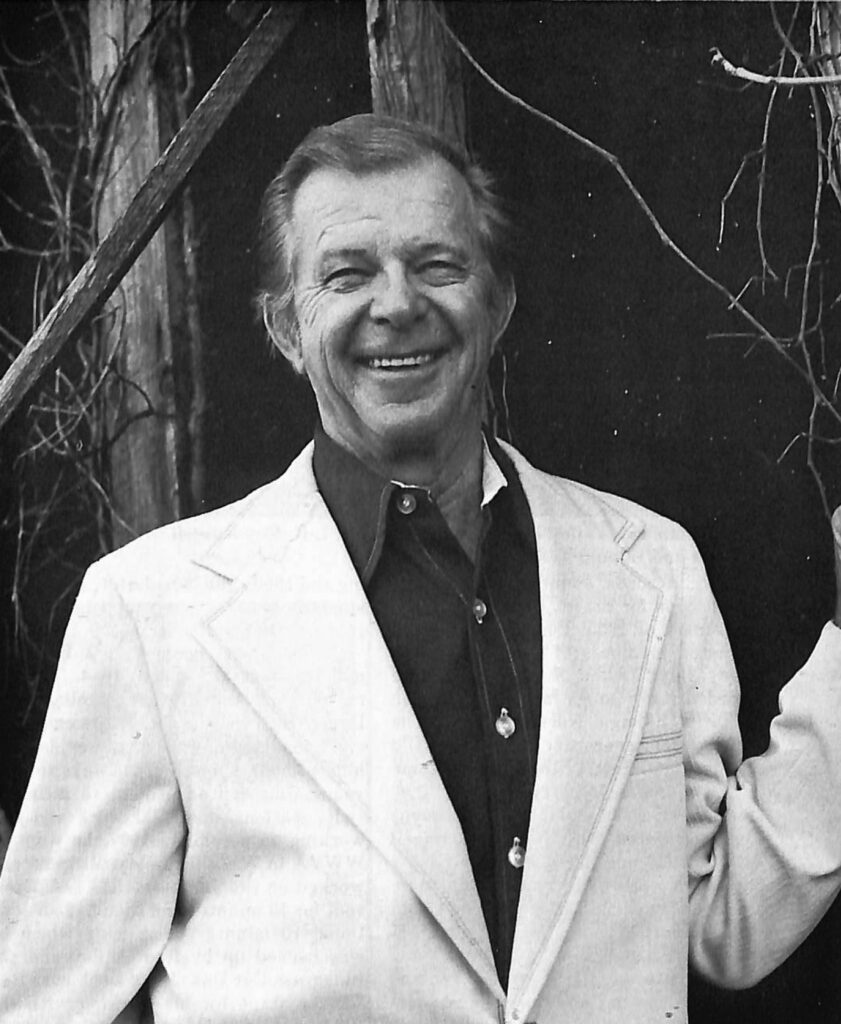
In 1984, Jim began to reorganize the Shenandoah Valley Boys and went through quite a few musicians until he came up with the group which he has now. The current lineup features David Shumaker on banjo, Billy Hurtz on fiddle, Matt Levine on Dobro, and John Cochran on bass. Jim is very proud of the current band. In addition to being very talented musicians, they all share an eagerness to work and display an enthusiasm for the music. Jim’s show today features a mix of ballads, older bluegrass songs, and a good balance of newer Eanes compositions.
Over the years, Jim’s music and songs have been an inspiration to many bluegrass and country musicians, starting with the birth of the music in the 1940s. Among the first to recognize and record his songs were Flatt & Scruggs when they recorded and popularized “Baby Blue Eyes” on one of their early Mercury sessions. In the middle and late 1950s, Don Reno and Red Smiley recorded several fine Eanes’ songs including “I Wouldn’t Change You If I Could,” “The New Jerusalem,” and “Christmas Doll.” George Jones scored in the 1960s with “Your Old Standby,” a song which George recorded on four separate occasions. Today, Jim continues to be popular with top country stars as well as traditional bluegrass bands. Probably the most popular personality to use Jim’s material recently is Ricky Skaggs, who had a number one hit with “I Wouldn’t Change You If I Could.” Among the bluegrass bands, newer traditional artists like Larry Sparks and the Johnson Mountain Boys are finding excellent material from Jim’s impressive catalog of songs.
At a time when many musicians of his generation are content to rest on their laurels, Jim Eanes remains enthusiastic and excited about his music and the future. He and the Shenandoah Valley Boys rehearse regularly to keep the sound fresh and together. And Jim continues to write new songs and has plans to record an album of all new material. But for Jim, music is not and never has been a strictly commercial proposition. Music is the driving force in his life, both personally and professionally, and that is the reason he is able to retain his enthusiasm and continue to perform and compose music which touches the hearts of those who love good bluegrass and country music.
